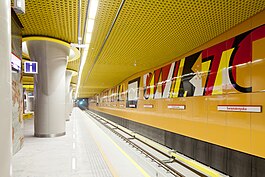| Warsaw Metro | |
|---|---|
 | |
 M2 platform at Świętokrzyska station | |
| Overview | |
| Native name | Metro Warszawskie |
| Owner | City of Warsaw |
| Locale | Warsaw, Poland |
| Transit type | Rapid transit |
| Number of lines | 2 (3 more planned) |
| Number of stations | 39 |
| Annual ridership | 200.0 million (2023)[1] |
| Website | Metro Warszawskie Warsaw Public Transport |
| Operation | |
| Began operation | 7 April 1995 |
| Operator(s) | Metro Warszawskie |
| Technical | |
| System length | 41.3 km (25.7 mi)[2] |
| Track gauge | 1,435 mm (4 ft 8+1⁄2 in) standard gauge |
| Electrification | 750 V DC third rail |
The Warsaw Metro (Polish: Metro Warszawskie) is a rapid transit underground system serving the Polish capital Warsaw. It currently consists of two lines, the north–south M1 line which links central Warsaw with its densely populated northern and southern districts, and the east–west M2 line. Three more lines (M3, M4, and M5) are planned.[3] The system is operated by Metro Warszawskie, a company owned by the city, and managed by Public Transport Authority in Warsaw. As of 2024, it is the only metro system in Poland.
The first section of M1 was opened in 1995 and the line was gradually extended until it reached its full length in October 2008. The contract for the construction of the initial central section of M2 was signed on 28 October 2009 and construction began on 16 August 2010.[4][5] The initial segment of M2, measuring 6.3 kilometres (3.9 miles) with seven stations,[2] one of which, Świętokrzyska, includes a transfer between the two lines, was opened on 8 March 2015.[6][7] The line's further extensions have been opening since 2019, and it is expected to be completed in 2026, when it will have 21 stations.[8][9]
In February 2023, the mayor of Warsaw Rafał Trzaskowski released a plan for the Warsaw Metro, calling for five metro lines by the year 2050. The plan includes constructing two additional M1 stations, Plac Konstytucji and Muranów, extending M2 line to Marymont and Ursus-Niedźwiadek, as well as construction of three new lines: M3, M4, and M5. With those extensions the metro would directly serve 17 out of Warsaw’s 18 districts.[10]
- ^ "Raport Roczny 2023" [Annual report 2023] (PDF). Zarząd Transportu Miejskiego w Warszawie. 2024. p. 16. Retrieved 2024-07-20.
- ^ a b "Raport roczny 2015" [Annual Report 2015] (PDF) (in Polish and English). 2016. p. 9. Retrieved 2017-01-04.
- ^ "Warszawa: III linia metra – jest już koncepcja pierwszego odcinka".
- ^ Polish website of Warsaw Metro - Line 2 information and maps
- ^ PAP. "Wielka chwila: ruszają prace przy drugiej linii metra" (in Polish). Gazeta.pl. Retrieved 2010-08-13.
- ^ "Warsaws second metro line opens". Radio Poland. March 8, 2015. Retrieved 2015-03-09.
- ^ "Crowds take first ride on Warsaws new subway line". U-T San Diego. Associated Press. March 8, 2015. Retrieved 2015-03-08.
- ^ "TLC Involved in Project to Expand Warsaw Metro System". TLC. April 25, 2019. Retrieved 2019-04-25.
- ^ "Trzaskowski: Metrem na Karolin pojedziemy w 2026 r." www.transport-publiczny.pl (in Polish). Retrieved 2023-10-27.
- ^ "Stolica pięciu linii metra". Urząd m.st. Warszawy (in Polish).
